Golden Moments |
|||||||||||||||||||||||||||||||||||||
 |
 |
||||||||||||||||||||||||||||||||||||
Knitted jumper with raglan in DROPS Belle. Piece is knitted top down with lace pattern, cables and bobbles. Size XS–XXL.
DROPS 213-16 |
|||||||||||||||||||||||||||||||||||||
|
---------------------------------------------------------- EXPLANATION FOR THE PATTERN: ---------------------------------------------------------- PATTERN: See diagrams A.1 to A.6. Choose diagram for your size (applies to A.1 and A.3). INCREASE/DECREASE TIP (evenly): To calculate how to increase/decrease evenly, use the total number of stitches on row (e.g. 92 stitches) , divide stitches by number of increases/decreases to be done (e.g. 28) = 3.2. In this example increase by making 1 yarn over after approx. 3rd stitch. On next round work yarn overs twisted to avoid holes. To decrease in this example knit approx. every 2nd and 3rd stitch together. RAGLAN: Increase 1 stitch on each side of marker thread as follows: Work until 1 stitch remains before marker thread, make 1 yarn over, knit 2, (marker thread is between these stitches), make 1 yarn over. On next round knit yarn overs twisted to avoid holes. Then work the new stitches in pattern. DECREASE TIP (applies to sleeves): If the lace pattern and decrease are on the same round, adjust so that decrease is on next round. Decrease 1 stitch on each side of marker thread as follows: Work until 3 stitches remain before marker thread and knit 2 together, knit 2 (marker thread is between these stitches), slip 1 stitch knitwise, knit 1, pass slipped stitch over stitch worked. CAST-OFF TIP: To avoid a tight cast-off edge you may use a larger needle size. If this also is too tight, work a 1 yarn over after approx. every 4th stitch while casting off (cast off yarn overs as regular stitches). ---------------------------------------------------------- START THE PIECE HERE: ---------------------------------------------------------- JUMPER - SHORT OVERVIEW OF THE PIECE: Neck edge and yoke are worked in the round on circular needle, top down. Now divide yoke for body and sleeves. Body is worked in the round on circular needle, top down. Work sleeves in the round on double pointed needles/short circular needle, top down. NECK EDGE: Cast on 92-92-96-100-108-112 stitches on circular needle size 3.5 mm with Belle. Knit 1 round. Then work rib (= knit 2/purl 2) in the round for 8 cm. When rib is done, knit 1 round while increasing 28-28-32-28-28-24 stitches evenly - read DECREASE/INCREASE TIP = 120-120-128-128-136-136 stitches. Purl 1 round and knit 1 round. Switch to circular needle size 4.5 mm. Insert 1 marker after approx. 23-23-24-24-25-25 stitches (= approx. mid back on back piece), measure yoke from this marker! YOKE: Now insert 4 marker threads in the piece without working: Insert first marker thread at the beginning of round (= in transition between left sleeve and back piece), insert next marker thread after 47-47-49-49-51-51 stitches (= in transition between back piece and right sleeve), insert next marker thread after 13-13-15-15-17-17 stitches (= in transition between right sleeve and front piece), insert next marker thread after 47-47-49-49-51-51 stitches (= in transition between front piece and left sleeve), 13-13-15-15-17-17 stitches remain on round after last marker thread. Now work pattern – choose diagram for your size, as follows: * Knit 1, make 1 yarn over, A.1 over the next 5-5-6-6-7-7 stitches, A.2 over the next 35 stitches, A.3 over the next 5-5-6-6-7-7 stitches, make 1 yarn over, knit 2 (marker thread is in the middle of these 2 stitches), make 1 yarn over, begin on 5th-5th-4th-4th-3rd-3rd stitch in A.4 and work the next 11-11-13-13-15-15 stitches, make 1 yarn over, knit 1 *, work from *-* 1 more time on round. 8 stitches have been increased for RAGLAN - read explanation above. Continue pattern like this and increase every other round 22-26-29-31-35-39 times in total = 296-328-360-376-416-448 stitches, at the same time work pattern as follows: REMEMBER THE KNITTING TENSION! Pattern for front and back piece: When A.1 and A.3 have been worked vertically, work A.5 over the last 13 stitches in A.1 and A.6 over the first 13 stitches in A.3, work the remaining stitches towards each raglan in stocking stitch until 16 increases have been worked for raglan. Then when beginning 3rd lace pattern vertically on sleeves (i.e. on 33rd round on yoke), work lace pattern (A.4) the same way as on sleeves. I.e. there should always be 1-1-2-2-3-3 knit stitches between yarn over in lace pattern and increase for raglan. When increasing more stitches for raglan, work as many whole lace pattern as there is room for. Pattern sleeves: On sleeves repeat A.4 vertically and work as many lace patterns as there is room for in width. There should always be 1-1-2-2-3-3 knit stitches between yarn over in lace pattern and increase for raglan. When all increases for raglan are done, piece measures approx. 17-20-22-24-27-30 cm from marker. In size XS continue with pattern (without increases for raglan) until piece measures 20 cm from marker. If the piece is shorter than 20-22-24-27-30 cm in size S, M, L, XL and XXL continue pattern (without increases for raglan) until correct measurements. Work next round as follows: Work first 91-99-107-111-121-129 stitches (= back piece), slip the next 57-65-73-77-87-95 stitches on a stitch holder for sleeve, cast on 8-8-8-12-12-16 new stitches on needle (= in the side under sleeve), work the next 91-99-107-111-121-129 stitches (= front piece), slip the next 57-65-73-77-87-95 stitches on a stitch holder for sleeve, cast on 8-8-8-12-12-16 new stitches on needle (in the side under sleeve). Cut the yarn. Now finish body and sleeves separately. NOW MEASURE PIECE FROM HERE! BODY: = 198-214-230-246-266-290 stitches. Insert 1 marker thread in each side, in the middle of the new stitches cast-on in the side under the sleeves (= 4-4-4-6-6-8 new stitches on each side of marker thread). Begin round in one side. Continue in the round with pattern as before and work as many repetition with lace pattern as there is room for towards each side (lace patterns should fit on top of each other the same way as earlier in piece). Work the remaining stitches that do not fit lace pattern towards each side in stocking stitch (= 6-4-2-6-5-5 stitches between marker thread in the side and the outermost yarn over in lace pattern towards the side). Continue in the round like this until piece measures approx. 24-26-26-26-25-24 cm - adjust to finish after 1st, 2nd round, 14th-18th round or 30th-34th round in A.2. Work next round as follows: * Knit the first 19-23-27-31-36-42 stitches and increase at the same time 6-6-6-8-9-9 stitches evenly, knit over knit and purl over purl over the next 61 stitches, knit the next 19-23-27-31-36-42 stitches and increase at the same time 6-6-6-8-9-9 stitches evenly, work from *-* 1 more time on round = 222-238-254-278-302-326 stitches. Knit the first 25-29-33-39-45-51 stitches on round. Insert a marker thread here. This is now the beginning of round. Now work rib. There are 2 variants for rib over the 61 stitches in pattern. If you finish after 1st, 2nd or 30th-34th round in A.2 work rib-1, and if you finished after 14th-18th round in A.2 work rib-2. Rib-1: * Knit over knit and purl over purl over the first 18 stitches, knit 2, knit over knit and purl over purl over the next 21 stitches, knit 2, knit over knit and purl over purl over the next 18 stitches, (knit 2/2 purl) over the next 50-58-66-78-90-102 stitches *, work from *-* 1 more time on round. Rib-2: * Knit over knit and purl over purl over the first 61 stitches, (knit 2/2 purl) over the next 50-58-66-78-90-102 stitches *, work from *-* 1 more time on round. Continue like this until rib measures approx. 4 cm. Cast off with knit over knit and purl over purl - read CAST-OFF TIP. Jumper measures approx. 51-53-55-57-59-61 cm from shoulder and down. SLEEVES: Slip the 57-65-73-77-87-95 stitches from stitch holder in one side back on a short circular needle/double pointed needles size 4.5 mm and pick in addition up 1 stitch in each of the 8-8-8-12-12-16 new stitches cast on under sleeve = 65-73-81-89-99-111 stitches. Insert a marker thread in the middle of the new stitches. Move marker thread upwards when working. Use the marker later when decreasing under sleeve. Work pattern in the different sizes as follows: Size XS, S and M: Continue in the round with as many lace pattern as there is room for on round. Work the remaining stitches under sleeve in stocking stitch. When sleeve measures 4 cm, begin decrease under sleeve – read DECREASE TIP. Decrease like this approx. every 0-10-5 cm 1-3-6 times in total = 63-67-69 stitches. Now work as explained below. Size L, XL and XXL: Continue in the round with as many lace pattern as there is room for on round. Work the remaining stitches under sleeve in stocking stitch. At the same time on first round decrease stitches under sleeve - read DECREASE TIP. Decrease like this every other round 2-5-9 times, then every 4-3-2 cm 7-8-9 times in total = 71-73-75 stitches. All sizes: Continue until sleeve measures 38-40-39-37-34-32 cm from division. Knit 1 round while decreasing 23-23-25-23-25-23 stitches evenly = 40-44-44-48-48-52 stitches. Switch to double pointed needles size 3.5 mm. Knit 2/purl 2 in the round. When rib measures 4 cm, cast off with knit over knit and purl over purl - remember CAST-OFF TIP. Sleeve measures 42-44-43-41-38-36 cm in total from division. Work the other sleeve the same way. |
|||||||||||||||||||||||||||||||||||||
Diagram explanations |
|||||||||||||||||||||||||||||||||||||
|
|||||||||||||||||||||||||||||||||||||
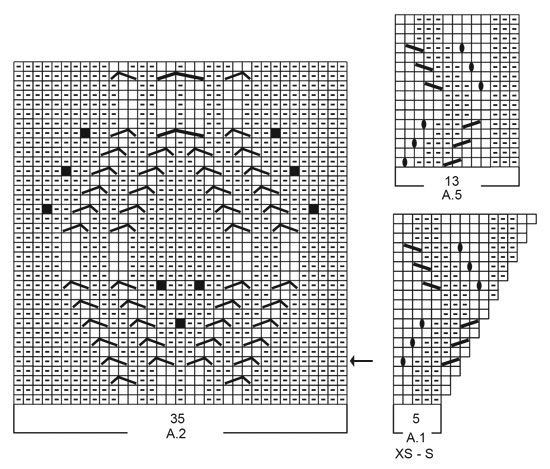
|
|||||||||||||||||||||||||||||||||||||
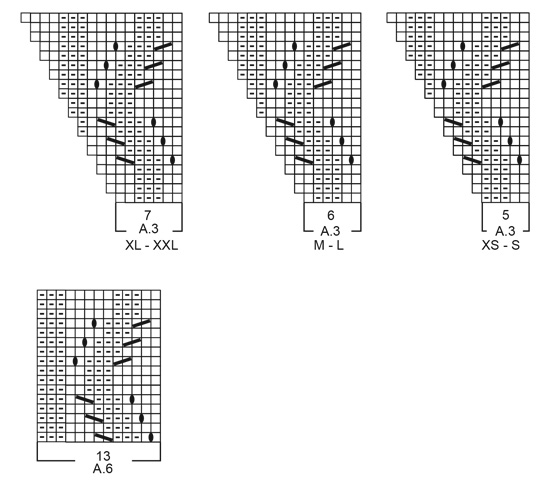
|
|||||||||||||||||||||||||||||||||||||
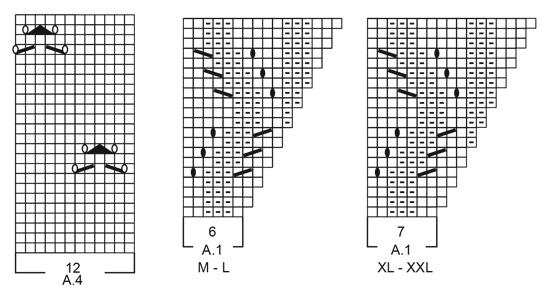
|
|||||||||||||||||||||||||||||||||||||

|
|||||||||||||||||||||||||||||||||||||
|
Have you made this or any other of our designs? Tag your pictures in social media with #dropsdesign so we can see them! Do you need help with this pattern?You'll find tutorial videos, a Comments/Questions area and more by visiting the pattern on garnstudio.com. © 1982-2024 DROPS Design A/S. We reserve all rights. This document, including all its sub-sections, has copyrights. Read more about what you can do with our patterns at the bottom of each pattern on our site. |
|||||||||||||||||||||||||||||||||||||











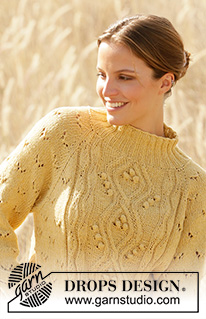
























































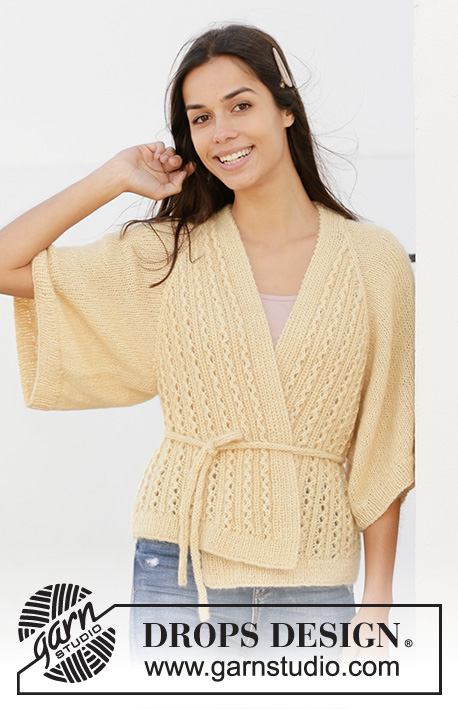







Comments / Questions (65)
I am following ‘S’ pattern. Thanks.
24.01.2021 - 16:23DROPS Design answered:
Dear Mrs Maharaj, I don't understand your question sorry, A.4 is 12 stitches and is worked at the beginning of the yoke for sleeves over 11 stitches starting with the 5th (= work the last 8 sts + the first 3 sts in diagram). Then when you will increase you have 2 sts more after every increase row. If you don't have enough sts to work a whole lace pattern (= as many yarn overs as decreases), just work the stitches in stocking stitch. Hope this helps. Happy knitting!
25.01.2021 - 10:22Hi, I am on the 33rd round where I have to start the A4 pattern in the stocking stitches. I have now (K1, YO, K8). K8 are the stocking stitches I have to fit the A4 pattern. The A4 pattern is of 7 stitches. It is not coming symmetric on both the ends of A5 and A6. How can I do it.? Pls help. Thanks.
23.01.2021 - 19:31How can I download the pattern to my computer? I don't want to print 27 pages. Thank you!
14.01.2021 - 05:25DROPS Design answered:
Hi Marina, When you have the pattern page open, right click on it and an instruction list will pop up, where you can click on 'save as' and save it with the name and place on your computer of your choice. Happy crafting!
14.01.2021 - 07:30Sorry, mijn laatste opmerking klopt niet, heb verkeerd gemeten...
12.01.2021 - 10:18Ik ben nu al op 20 cm en nog maar op de helft vd meerderingen.( 31x 8 meerderingen om de naald) klopt dat?? Moet nl bij ong 27cm beginnen met de mouw
12.01.2021 - 07:53DROPS Design answered:
Dag Tara,
Bij 31 keer meerderen om de naald, brei je 62 naalden in de hoogte en dat zou overeenkomen met ongeveer 24 cm in de hoogte als de stekenverhouding klopt (26 naalden in de hoogte = 24 cm). Misschien even je stekenverhouding controleren? En heb je ook vanaf na de boordsteek gemeten?
17.01.2021 - 12:49Vlgs mij klopt het patroon niet bij A1 ...als je moet meerderen met een omslag ben je niet ineens een hokje verder , weet niet zo goed hoe ik het moet uitleggen zonder het te laten zien ..maar vlgs mij klopt het patroon niet bij A1( mt L)
11.01.2021 - 12:57Grazie per la risposta. Quindi è corretto che alla fine del 6 giro del motivo A.1 mi ritrovo con 4 maglie dritte e non tre come da schema?
21.11.2020 - 22:54DROPS Design answered:
Buongiorno Giulia, indipendentemente della maglie che si trova, sul giro 6 di A.1, deve lavorare 3 maglie diritto, 3 maglie rovescio e 3 maglie diritto, lavorando a ritorto la maglia gettata del giro precedente. Buon lavoro!
26.11.2020 - 10:03Salve, Sto eseguendo il motivo in taglia M. Sono bloccata al motivo A.1 giro n 6. Come faccio ad avere le ultime tre maglie a diritto? Facendo la terzultima a diritto sulla terzultima a rovescio del 5 giro io mi ritrovo con 4 maglie a diritto alla fine del 6 giro. Mi ritrovo con tre maglie dritte sulle tre maglie dritte del 5 giro(1 diritto,1 gettato,1 diritto) più un'altra maglia diritta da fare sulla sesta maglia rovescio del 5 giro. Come devo fare per avere il motivo corretto?
21.11.2020 - 12:22DROPS Design answered:
Buonasera Giulia, deve considerare che all'inizio del giro 5 viene diminuita una maglia, quindi il lavoro si sposta di una maglia verso la destra del diagramma. Il numero delle maglie è corretto. Buon lavoro!
21.11.2020 - 21:11Buon pomeriggio, sto eseguendo il modello in taglia M e sono arrivata al ferro 11. Nel motivo A4 dovrei partire dalla 4 maglia per poi proseguire. Secondo me c'è un errore nello schema in quanto alla 4 maglia del ferro 11 corrisponde tutto un passaggio che include anche la 3 e la 5 maglia. Come devo procedere? Secondo me c'è un errore dal 9 ferro e bisogna iniziare il motivo dall'inizio e non dalla 4 maglia. Grazie
09.11.2020 - 16:03DROPS Design answered:
Buonasera Valentina, abbiamo inoltrato la sua richiesta al settore design. Buon lavoro!
15.11.2020 - 19:45Devo ricominciare il giro dall'inizio oppure sempre dalla 4° maglia? Grazie
05.11.2020 - 19:37DROPS Design answered:
Buongiorno Valentina, può riprendere dalla 1° maglia di A.4. Buon lavoro!
06.11.2020 - 09:44